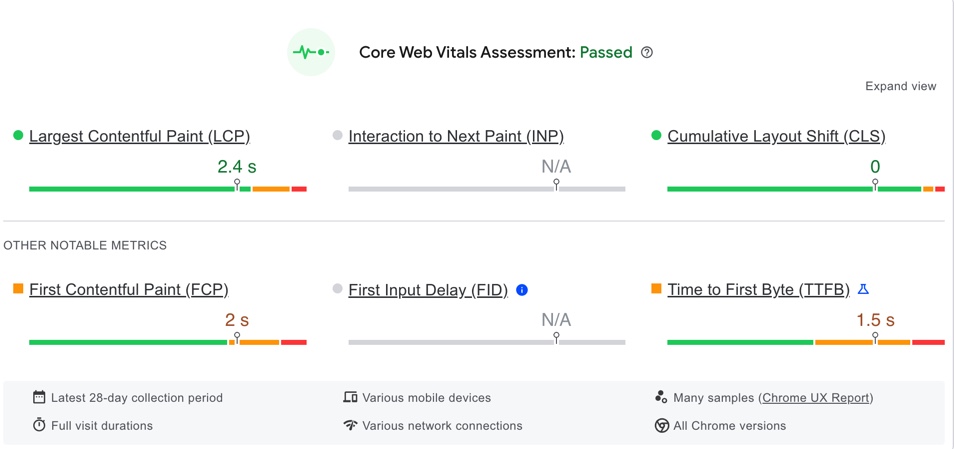In today’s fast-paced digital world, having an ecommerce website that attracts visitors is only half the battle. The real challenge lies in converting those visitors into paying customers, and there are a myriad of factors fighting against you including incredibly short attention spans, competitor promotions, and even your own website.
If your website isn’t performing optimally, you’re likely frustrated with conversion rates, scared you’ll miss revenue goals, and burdened by metrics that leave you feeling confused. You’re not alone. Many marketing leaders I talk to have these struggles.
In this article, we’ll explore the common issues that lead to low conversion rates and ways we’ve helped clients improve conversion rates, so that you can optimize your site to turn traffic into sales.
Low Conversion Rates Despite High Traffic
It’s a scenario we see all too often: an ecommerce site is generating a healthy amount of traffic, but the conversion rates aren’t reflecting that success. Visitors are landing on the site, browsing products, but when it comes time to make a purchase, they abandon the process.
This can be incredibly frustrating, especially when you’re investing heavily in traffic generation from paid media campaigns.
So, what’s going wrong? The answer often lies in the performance and usability of the website itself. We’ll explore the two primary drivers of low conversion rates that we see most often:
- Slow website speed
- Poor user experience
Slow Website Speed: A Culprit of Poor Website Performance
A slow website can be a major conversion killer. Studies show that:
-
- Even a 100-millisecond delay in website load time can hurt conversion rates by 7 percent
- A two-second delay in web page load time increase bounce rates by 103 percent
- 53 percent of mobile site visitors will leave a page that takes longer than three seconds to load
In a competitive ecommerce market, customers simply won’t wait around for a sluggish site—they’ll bounce to a competitor’s site that offers a faster, smoother experience.
How to Measure Website Speed
If you’re unsure if your website speed could be causing you problems, there are a variety of tools and metrics to measure site speed and performance. Enter your website URL in Google PageSpeed Insights to get your page speed score and use suggestions from Google to make your website faster.

These tools analyze factors such as server response times, image sizes, and the use of browser caching. Additionally, by monitoring key performance metrics like bounce rates and conversion rates—if users are leaving the site quickly or abandoning their carts, it may indicate a speed issue.
By regularly testing your site speed across different devices and networks, you can ensure that any potential bottlenecks are identified and resolved to keep the website running optimally.
Poor User Experience (UX): The Enemy of Conversion Rate Optimization
Beyond speed, user experience (UX) plays a crucial role in conversion rates. If your site is difficult to navigate, cluttered with unnecessary elements, or lacking a clear call to action, visitors are likely to get frustrated and leave before completing a purchase.
The most common user experience issues we see are in seven core areas.
- Confusing Navigation: If users can’t easily find what they’re looking for due to poor menu structure or disorganized content, they are more likely to abandon the site. All too often the people managing the website are too close to the product to see the issues users face with the navigation.
- Cluttered Design: Overly complex or cluttered designs with too many elements can overwhelm users, making it difficult to focus on the main content or call to action (CTA). Be selective in your design elements, giving shoppers all they need but not more than they want.
- Unresponsive or Poor Mobile Optimization: Across our ecommerce clients, we see about 60-70% of website traffic coming from mobile devices, websites that are not optimized for mobile (e.g., difficult to read text, non-adjustable layouts) drive users away almost immediately.
- Complex or Lengthy Checkout Processes: For ecommerce sites, a complicated or multi-step checkout process can result in cart abandonment. Simple, streamlined checkouts lead to higher conversion rates.
- Broken Links or Errors: Encountering 404 errors, broken links, or malfunctioning buttons can frustrate users, causing them to lose trust in the site and leave.
- Intrusive Ads or Pop-Ups: Aggressive pop-ups, auto-playing videos, or too many ads can disrupt the user experience, making users feel overwhelmed or annoyed
- Lack of Clear CTAs: If users are unsure of what action to take next due to vague or poorly placed calls to action, they are less likely to engage or convert
Addressing these issues is essential to creating a smooth, intuitive, and user-friendly experience that encourages engagement and drives conversions.
Optimizing Your Website for Performance and Conversions
As the senior director of digital experience at LimeLight Marketing, I work with ecommerce clients and lead our internal team to solve simple and complex website performance issues.
If you’re frustrated with your website performance, and aren’t sure where to focus your efforts, we offer a variety of audits to help you identify where your issues are and how to best solve them.
If you need help optimizing your websites to achieve higher conversion rates and, ultimately, more sales, here’s how we do it:
Improving Load Times
The faster your site loads, the better. We focus on optimizing your site’s speed by compressing images, leveraging browser caching, and minimizing code. These technical improvements ensure that your pages load quickly, keeping visitors engaged and reducing bounce rates.
Enhancing User Experience (UX)
A seamless, intuitive user experience is key to converting visitors into customers. We analyze your site’s design and functionality to ensure that navigation is easy, the layout is clean, and the path to purchase is clear. This includes streamlining your checkout process to minimize cart abandonment.
Mobile Optimization
Mobile optimization—it’s essential. We make sure your website is responsive and provides an excellent experience across all devices, helping you capture more sales from mobile shoppers.
A/B Testing and Continuous Improvement
Optimizing a website isn’t a one-time task; it requires continuous testing and tweaking. We implement A/B testing to compare different versions of your site’s key pages, allowing us to identify what works best for your audience. This data-driven approach helps us refine your site’s performance over time, ensuring sustained improvements in conversion rates.
Turn Traffic into Sales with a High-Performing Website
If your ecommerce website isn’t converting as it should, it’s time to take a closer look at its performance and user experience. By addressing the issues that are slowing down your site and frustrating your visitors, you can significantly boost your conversion rates and unlock more revenue.
At LimeLight Marketing, we have the expertise and tools to optimize your website for peak performance. Don’t let a sluggish site cripple your business growth—let’s work together to turn your traffic into sales.
Ready to get started? Contact us today to learn how we can help you optimize your ecommerce website and boost your conversion rates.


